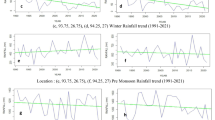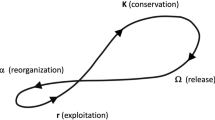Abstract
Many studies of land-cover and structural changes in cultural landscapes have used historical maps as a source for information about past land-cover. All transformations of historical maps onto modern coordinate systems are however burdened with difficulties when it comes to accuracy. We show that a detailed land survey of the present landscape may enable transformation of an old cadastral map directly onto the present terrain with very high accuracy. The detailed resulting map enabled us to locate remnants of semi-natural grasslands and man-made structures with continuity from 1865 and to test hypotheses about relationships between landscape changes and landscape characteristics. The main land-cover change 1865–2002 was decrease of arable fields, and addition of three new land-cover classes: horticultural, orchard and abandoned areas. Of the 330 man-made structures present in 1865, only 58 remained in 2002, while 63 new structures had been built after 1865. We found that semi-natural grasslands with continuity since 1865 were situated on ground with significantly lower production capacity than mean 1865 production capacity. The man-made structures with continuity since 1865 were also associated with areas with significantly lower production capacity than the 1865 mean, situated in significantly steeper terrain but not further from the hamlet. Our study illustrates the potential of digitised and accurately transformed historical cadastral maps combined with detailed field surveys for analysis of land-cover and structural changes in the cultural landscape.





Similar content being viewed by others
References
Almås R (2002) Norges landbrukshistorie IV. 1920–2000, Frå bondesamfunn til bioindustri. Det norske samlaget, Oslo
Anonymous (1994) PC Arc/Info. Environmental Systems Research Institute (ESRI), Inc., Redlands, California
Anonymous (1996a) ArcView GIS 3.2. Environmental Systems Research Institute (ESRI), Inc., Redlands, California
Anonymous (1996b) ArcView Spatial Analyst. Environmental Systems Research Institute (ESRI), Inc., Redlands, California
Anonymous (1997) ArcView 3D Analyst. Environmental Systems Research Institute (ESRI), Inc., Redlands, California
Austad I, Øye I (2001) The traditional West Norwegian farm as a biological and cultural system. In: Skar B (ed) Cultural heritage and the environment. In Norwegian with english summaries. Signatur AS, Oslo, pp 135–205
Bakker JP (1989) Nature management by grazing and cutting. On the ecological significance of grazing and cutting regimes applied to restore former species-rich grassland communities in the Netherlands. Kluwer Academic Publishers, Dordrecht
Bastian O, Bernhardt A (1993) Anthropogenic landscape changes in central-Europe and the role of bioindication. Landsc Ecol 8:139–151
Bender O, Boehmer HJ, Jens D et al (2005a) Analysis of land-use change in a sector of Upper Franconia (Bavaria, Germany) since 1850 using land register records. Landsc Ecol 20:149–163
Bender O, Boehmer HJ, Jens D et al (2005b) Using GIS to analyse long-term cultural landscape change in southern Germany. Landsc Urban Plan 70:111–125
Bennie J, Hill MH, Baxter R et al (2006) Influence of slope and aspect on long-term vegetation change in British chalk grasslands. J Ecol 94:355–368
Benton TG, Vickery JA, Wilson JD (2003) Farmland biodiversity: is habitat heterogeneity the key. Trends Ecol Evol 18:182–188
Clarke DG, Clark DM (1995) Lineage. In: Guptill SC, Morrison JL (eds) Elements of spatial data quality. Elsevier Science, Oxford, pp 13–30
Cousins SAO (2001) Analysis of land-cover transitions based on 17th and 18th century cadastral maps and aerial photographs. Landsc Ecol 16:41–54
Daugstad K (2005) Agriculture’s role as an upholder of cultural heritage. TemaNord 576:1–127
Domaas ST (2007) The reconstruction of past patterns of tilled fields from historical cadastral maps using GIS. Landsc Res 32:23–43
Domaas ST (2005) Structural analyses of features in cultural landscapes based on historical cadastral maps and GIS. Dissertation, Swedish University of Agricultural Sciences
Domaas ST, Austad I, Timberlid JA et al (2003) Historical cadastral maps as tool for valuation of today’s landscape elements. In: Palang H, Fry G (eds) Landscape interfaces. Cultural heritage in changing landscapes. Kluwer Academic Publishers, Dodrecht, pp 221–236
Dutoit T, Buisson E, Roche P et al (2004) Land use history and botanical changes in the calcareous hillsides of Upper-Normandy (North-Western France): new implications for their conservation management. Biol Cons 115:1–19
Fjellstad WJ, Dramstad WE (1999) Patterns of change in two contrasting Norwegian agricultural landscapes. Landsc Urb Plan 45:177–191
Fry G, Sarlöv-Herlin I (1997) The ecological and amenity functions of woodland edges in the agricultural landscape: a basis for design and management. Landsc Urb Plan 37:45–55
Fry GLA, Skar B, Jerpåsen G et al (2004) Locating archaeological sites in the landscape: a hierarchical approach based on landscape indicators. Landsc Urb Plan 67:97–107
Haines-Young R, Barr CJ, Firbank LG et al (2003) Changing landscapes, habitats and vegetation diversity across Great Britain. J Environm Manage 67:267–281
Hietala-Koivu R, Järvenpää T, Helenius J (2004) Value of semi-natural areas as biodiversity indicators in agricultural landscapes. Agric Ecosyst Environ 101:9–19
Hietel E, Waldhardt R, Otte A (2004) Analysing land-cover changes in relation to environmental variables in Hesse, Germany. Landsc Ecol 19:473–489
Hamre LN, Austad I (1999) Field margin vegetation on farms in Sogn, western Norway. Aspects Appl Biol 54:337–344
Hodgson JG, Grime JP, Wilson PJ et al (2005) The impacts of agricultural change (1963–2003) on the grassland flora of Central England: processes and prospects. Basic Appl Ecol 6:107–118
Ihse M (1995) Swedish agricultural landscapes—patterns and changes during the last 50 years, studied by aerial photos. Landsc Urb Plan 31:21–37
Jongman RHG (2002) Homogenisation and fragmentation of the European landscape: ecological consequences and solutions. Landsc Urb Plan 58:211–221
Kain JPK, Baigent E (1992) The cadastral map in the service of the state. A history of property mapping. The university of Chicago press, Chicago
Kienast F (1993) Analysis of historic landscape patterns with a Geographic Information System—a methodological outline. Landsc Ecol 8:103–118
Kristensen SP (1999) Agricultural land use and landscape changes in Rostrup, Denmark: processes of intensification and extensification. Landsc Urb Planning 46:117–123
Kvamme M, Austad I, Hauge L et al (1999) Kulturmarkene i historisk og regionalt perspektiv. In: Norderhaug A, Austad I, Hauge L et al (eds) Skjøtselsboka for kulturlandskap og gamle norske kulturmarker. Valdres Trykkeri, Fagernes, pp 21–34
Legendre P, Legendre L (1998) Numerical ecology, ed 2. Elsevier, Amsterdam
Lia V (2005) Bruk og uttrykk gjennom tid i et jordbrukslandskap. Ornes i Luster. En arkeologisk landskapsanalyse med punktundersøkelser i innmark. University of Bergen, Hovedfagsoppgave
Losvik MH (1988) Phytosociology and ecology of old hay meadows in Hordaland, western Norway in relation to management. Vegetatio 78:157–187
Lundberg A, Handegaard T (1996) Changes in the spatial structure and function of coastal cultural landscapes. Geo Journal 39:167–178
Luoto M, Rekolainen S, Aakkula J et al (2003) Loss of plant species richness and habitat connectivity in grasslands associated with agricultural change in Finland. Ambio 32:447–452
Myklestad Å, Sætersdal M (2003) Effects of reforestation and intensified land use on vascular plant species richness in traditionally managed hay meadows. Anns Bot Fenn 40:423–441
Nitter C, Uchermann F (1865) Kart over indmark til gaardene Urnæs. Solvorns og Marifjærens Thinglag, Hafslo Præstegjeld, Sogns Fogderi, Nordre Bergenshus Amt. Riksarkivet, Oslo
Norderhaug A, Ihse M, Pedersen O (2000) Biotope patterns and abundance of meadow plant species in a Norwegian rural landscape. Landsc Ecol 15:201–218
Pedersen EA (1990) Rydningsrøysfelt og gravminner—spor av eldre bosetningsstruktur på Østlandet. Viking. Tidsskrift for Norrøn Arkeologi LIII:50–66
Peppler-Lisbach C (2003) Predictive modelling of historical and recent land-use patterns. Phytocoenologia 33:565–590
Poschlod P, Bakker JP, Kahmen S (2005) Changing land use and its impact on biodiversity. Basic Appl Ecol 6:93–98
Pärtel M, Mändla R, Zobel M (1999) Landscape history of a calcareous (alvar) grassland in Hanila, western Estonia, during the last three hundred years. Landsc Ecol 14:187–196
Ruuska R, Helenius J (1996) GIS analysis of change in an agricultural landscape in Central Finland. Agric Food Sci Finl 5:567–576
Skånes H (1990) Changes in the rural landscape and the impact on flora—a retrospective case-study using aerial photographs. Geogr Ann 72:129–134
Statens K (1999) SOSI. Samordnet opplegg for stedfestet informasjon. Et standardformat for digitale geodata, versjon 3.1. Hønefoss
Timberlid JA (1988) Driftsendringar i jordbruket som årsak til forsuring av norske vassdrag? Ein samanliknande studie av utmarksbruken på Vest- og Sørlandet i perioden 1850–1980. Økoforsk rapport 14:1–354
van Eetvelde V, Antrop M (2004) Analyzing structural and functional changes of traditional landscapes—two examples from Southern France. Landsc Urb Plan 67:79–95
Vuorela N, Alho P, Kalliola R (2002) Systematic assessment of maps as source information in landscape-change research. Landsc Res 27:141–166
Widgren M (1997) Fossila landskap. En forskningsöversikt over odlingslandskapets utvecling från yngre bronsålder till tidlig medeltid. Kulturgeografisk Seminarium 1.197, Stockholm
Acknowledgements
We acknowledge all the landowners who kindly permitted us to survey their land properties. Asle Lerum, Daniel Lerum, John A. Gladsø, Inger Auestad and Stein Joar Hegland are thanked for inestimable help with the field work. Inger Auestad and Rune H. Økland gave valuable comments on the manuscript. This work is funded by the Norwegian Ministry of Education and Research, project: Landscape changes in rural areas. We have also received financial support from the Norwegian Directorate for cultural heritage and Luster municipality.
Author information
Authors and Affiliations
Corresponding author
Rights and permissions
About this article
Cite this article
Hamre, L.N., Domaas, S.T., Austad, I. et al. Land-cover and structural changes in a western Norwegian cultural landscape since 1865, based on an old cadastral map and a field survey. Landscape Ecol 22, 1563–1574 (2007). https://doi.org/10.1007/s10980-007-9154-y
Received:
Accepted:
Published:
Issue Date:
DOI: https://doi.org/10.1007/s10980-007-9154-y




